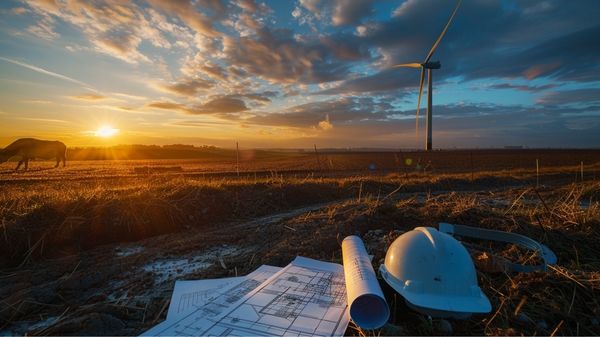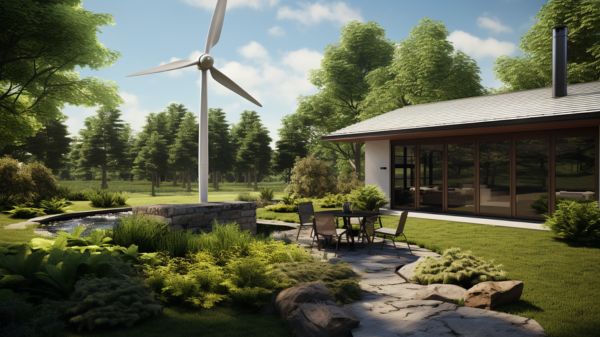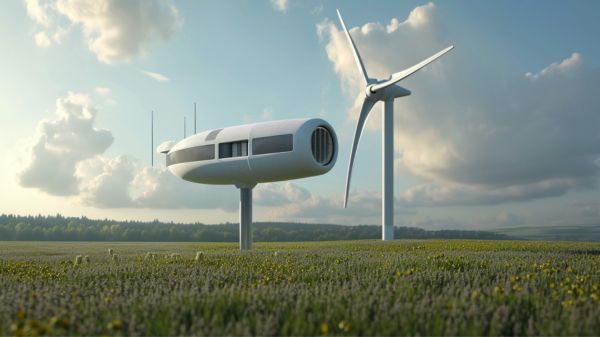In today’s world, where sustainable energy solutions are gaining prominence, residential wind turbines have emerged as a viable option for individuals seeking to reduce their carbon footprint and generate their own electricity. By harnessing the power of wind, these turbines can provide a renewable source of energy that is both environmentally friendly and cost-effective.
This comprehensive guide aims to provide detailed information on the installation, maintenance, and environmental impact of residential wind turbines. Through a step-by-step approach, readers will be equipped with the necessary knowledge and skills to successfully install and maintain their own wind turbine systems.
Additionally, this guide will explore the environmental benefits of wind power and potential mitigation strategies for any associated impacts. By understanding the intricacies of residential wind turbines, readers will be able to make informed decisions regarding their energy consumption and contribute to a more sustainable future.
Key Takeaways
- Regular maintenance is crucial for optimal performance and extended lifespan of residential wind turbines.
- Careful placement, proper alignment, and strategic location can help mitigate harm to birds.
- Tax credits and incentives can promote the adoption of residential wind turbines and make wind energy more financially appealing.
- Solar power and wind power have different characteristics and suitability depending on location, space, and preferences.
Residential Wind Turbine Basics
This discussion focuses on the basics of residential wind turbines.
Home wind turbines are devices that convert wind energy into electrical energy. They can be used to power homes and reduce reliance on traditional energy sources.
When properly installed and maintained, these turbines can provide numerous benefits. These include energy cost savings and reduced carbon emissions.
However, it is important to consider factors such as wind availability, noise levels, and visual impact when deciding to install a home wind turbine.
Additionally, the environmental impact of home wind turbines is generally positive. They produce clean, renewable energy and contribute to the reduction of greenhouse gas emissions. This promotes sustainability in the long run.
Definition and Functionality
Residential wind turbines operate by utilizing the force of wind to rotate a rotor, which in turn drives a generator to produce electricity. The rotor is a key component of a wind turbine and consists of multiple blades that capture the kinetic energy of the wind.
The generator converts the rotational motion of the rotor into electrical energy, which can then be used to power homes. In order to ensure optimal functionality, regular maintenance of the turbine is required. This involves inspecting and lubricating the moving parts, monitoring the performance of the generator, and repairing any damages or malfunctions.
Additionally, the installation of a residential wind turbine should consider factors such as wind speed and direction, as well as local zoning regulations.
From an environmental standpoint, residential wind turbines offer a clean and renewable source of energy, reducing reliance on fossil fuels and minimizing carbon emissions.
Benefits and Considerations
One important factor to consider when implementing wind turbines is the potential benefits they can bring to off-grid communities, such as reduced energy bills and increased self-sufficiency.
Residential wind turbines offer a cost-effective solution for generating renewable energy at home. The cost of residential wind turbine kits varies depending on the size and type of turbine, but generally, they are more affordable than other renewable energy systems. Additionally, plug-and-play residential wind turbines are available, making installation easier and more convenient.
When selecting the best residential wind turbine, factors such as wind conditions, noise levels, and maintenance requirements should be considered. Residential vertical wind turbines are a popular choice for urban areas with limited space.
Overall, investing in a residential wind turbine can lead to long-term savings on energy bills and contribute to a greener and more sustainable future.
Environmental Impact and Sustainability
The sustainability of wind power can be assessed by evaluating its carbon footprint and its contribution to reducing greenhouse gas emissions. Wind turbines for residential use, such as plug and play residential wind turbines or residential wind turbine kits, offer an eco-friendly and renewable energy solution. These small-scale wind turbines can be installed on rooftops or in open areas, harnessing the power of wind to generate electricity.
By utilizing wind energy, homeowners can reduce their reliance on fossil fuels and decrease their carbon emissions. Wind power is a clean and sustainable energy source that does not produce harmful pollutants or greenhouse gases during operation. Additionally, wind power contributes to energy independence by reducing the need for traditional electricity sources.
Investing in residential wind turbines not only benefits the environment but also promotes a greener and more sustainable future.
Installation and Maintenance
This paragraph will discuss key points related to the installation and maintenance of home wind turbines.
The first important aspect is choosing the location for the turbine, which requires careful consideration of factors such as wind speed, direction, and obstructions.
Professional installation is highly recommended to ensure proper installation and avoid potential safety hazards.
Additionally, regular maintenance is crucial for the longevity of the turbine. This involves tasks such as cleaning, lubrication, and inspection of components to ensure optimal performance and prevent potential issues.
Choosing the Location
Interestingly, the optimal location for installing a home wind turbine involves a complex interplay of factors such as wind speed, direction, site viability, zoning ordinances, building permits, and height restrictions, which can be quite challenging to navigate. When choosing the location for a home wind turbine, it is essential to consider the following:
Wind Speed and Direction
- The wind speed should be sufficient to generate a significant amount of electricity.
- The wind direction should be consistent and unobstructed to ensure optimal performance.
Site Viability
- The site should have enough open space to accommodate the turbine and its blades.
- It should not be prone to excessive turbulence or wind shear, which can affect the turbine’s efficiency.
Navigating zoning ordinances, building permits, and height restrictions can be daunting. However, it is crucial to ensure compliance with local regulations to avoid legal issues.
By carefully considering these factors, homeowners can select the most suitable location for their wind turbine, maximizing its efficiency and environmental impact.
Professional Installation
Professional installation of a wind turbine by a qualified installer is essential for ensuring a safe and efficient setup that adheres to industry standards and regulations. Hiring a professional installer brings numerous benefits, including their expertise and knowledge in handling complex electrical systems. They have the necessary skills to properly assemble and install the turbine, ensuring that it operates at its optimum capacity.
Additionally, a professional installer can provide guidance in obtaining necessary permits and licenses, reducing the risk of legal issues. When searching for a credible installer, it is important to check their credentials and references. Look for certifications and licenses that demonstrate their competency in wind turbine installation. Contacting previous clients and reading reviews can also help gauge their reliability and professionalism.
By entrusting the installation to a licensed professional, homeowners can have peace of mind knowing that their wind turbine will be installed correctly and safely.
Maintenance and Longevity
Moving on from the professional installation process, it is essential to understand the significance of maintenance and longevity when it comes to home wind turbines. Proper maintenance not only ensures the optimal performance of the system but also extends its lifespan.
Annual maintenance tasks, such as bolt and electrical connection checks, are recommended to identify and address common issues like corrosion and tension problems. Additionally, replacing worn-out components is crucial, and it is worth noting that service and maintenance programs are available to assist with this.
To provide a visual representation of the importance of maintenance, consider the following table:
| Importance of Maintenance | Benefits | Consequences |
|---|---|---|
| Ensures optimal performance | Increased energy production | Decreased energy output |
| Extends lifespan | Cost savings on repairs | Early system failure |
| Identifies and addresses issues | Enhanced safety | Potential damage to property |
By adhering to a regular maintenance routine, homeowners can maximize their wind turbine’s efficiency, minimize costs, and enjoy a sustainable energy solution for years to come.
Environmental Impact and Mitigation
One way to mitigate the environmental impact of wind turbines is through careful placement, as this can minimize harm to birds and potentially affect their migration patterns. Proper alignment of wind turbines is crucial in ensuring their negative impact on wildlife is minimized.
By strategically locating turbines away from important bird habitats and migration corridors, the risk of collisions and disturbance to avian species can be significantly reduced.
Additionally, implementing mitigation measures such as painting turbines black and using ultrasonic sound machines can further minimize the potential harm to birds. These measures help to increase the visibility of the turbines and deter birds from flying too close to them.
However, it is important to note that the effectiveness of these mitigation strategies may vary depending on the specific species and location of the wind turbines. Therefore, thorough research and careful planning are essential to ensure the successful implementation of these measures.
Tax Credits and Incentives
Another significant aspect to consider when exploring wind energy options is the availability of tax credits and incentives. These incentives aim to promote the adoption of small residential wind turbines and offset the installation costs.
For turbines producing up to 100 kilowatt-hours of energy, homeowners can benefit from tax credits that reduce their tax liability. Additionally, these incentives apply to both existing and new construction homes, encouraging homeowners to invest in wind energy regardless of their property type.
To make it even more enticing, here are some amusing benefits of these tax credits and incentives:
- Your bank account will grow faster than a wind turbine in a hurricane!
- Say goodbye to Uncle Sam taking a big bite out of your wallet; these incentives will shrink your tax bill like a deflating balloon!
So, if you’re considering installing a home wind turbine, don’t forget to explore the tax credits and incentives available to you. It’s a win-win situation for the environment and your pocket!
Alternatives to Wind Power
Among the various alternative energy sources available, solar and wind power stand out as promising options due to their unique advantages and limitations.
Solar power harnesses the energy of the sun by converting sunlight into electricity through photovoltaic cells. It is a widely accessible and renewable energy source, making it suitable for both urban and rural areas. Solar panels are low maintenance and can be installed on rooftops or in open spaces.
On the other hand, wind power utilizes the force of the wind to generate electricity through wind turbines. It is particularly beneficial in windy regions and can provide a significant amount of energy. However, wind power requires large open spaces and can be noisy and visually unappealing.
Ultimately, the choice between solar and wind power depends on factors such as location, available space, and individual preferences.
Solar Vs. Wind Power
- Solar Power: Photovoltaic cells, panels, inverters, battery storage
- Wind Power: Wind turbines, generators, towers, battery storage
Pros
- Solar Power: Renewable, accessible, low maintenance, suitable for urban and rural areas
- Wind Power: Renewable, high energy output, suitable for windy regions
Cons
- Solar Power: Dependence on sunlight, limited energy storage capacity
- Wind Power: Requirement of large open spaces, noise and visual impact
Frequently Asked Questions
What are the average installation costs for a home wind turbine?
The average installation costs for a home wind turbine vary depending on factors such as the size and type of turbine, location, and additional equipment needed. Costs can range from $10,000 to $70,000.
Are there any specific regulations or permits required for installing a home wind turbine?
Specific regulations and permits are necessary for installing a home wind turbine. These requirements vary by location and may involve obtaining building permits, complying with zoning ordinances, and following electrical and safety codes.
How noisy are home wind turbines and can they cause disturbances to neighboring properties?
Home wind turbines produce varying levels of noise depending on their size and design. While some models can be as quiet as a whisper, others can generate more noticeable noise. However, the disturbances caused to neighboring properties are generally minimal.
Can a home wind turbine generate enough energy to power an entire household?
Yes, a home wind turbine can generate enough energy to power an entire household. Wind turbines convert the kinetic energy from the wind into electrical energy, which can be used to power various household appliances and systems.
Are there any specific safety precautions or considerations that need to be taken during the installation and maintenance of a home wind turbine?
Safety precautions and considerations during the installation and maintenance of home wind turbines include proper grounding, regular inspection of components, and adherence to manufacturer guidelines. Following these measures ensures safe operation and reduces the risk of accidents.
Conclusion
Residential wind turbines offer a promising solution for sustainable energy generation. Their installation and maintenance require careful planning and adherence to safety guidelines. By harnessing the power of wind, these turbines contribute to reducing carbon emissions and mitigating environmental impact. Additionally, homeowners can benefit from tax credits and incentives, making wind power a cost-effective choice. While there are alternatives to wind power, the image of a serene landscape dotted with spinning turbines evokes a sense of harmony between nature and technology, leaving a lasting impression on our collective consciousness.




